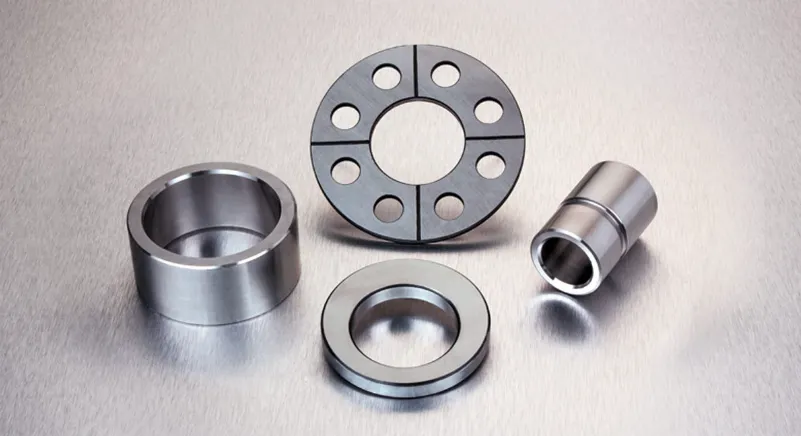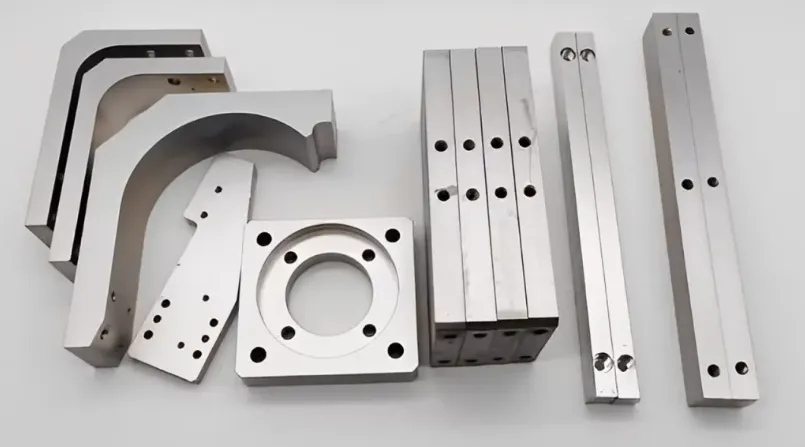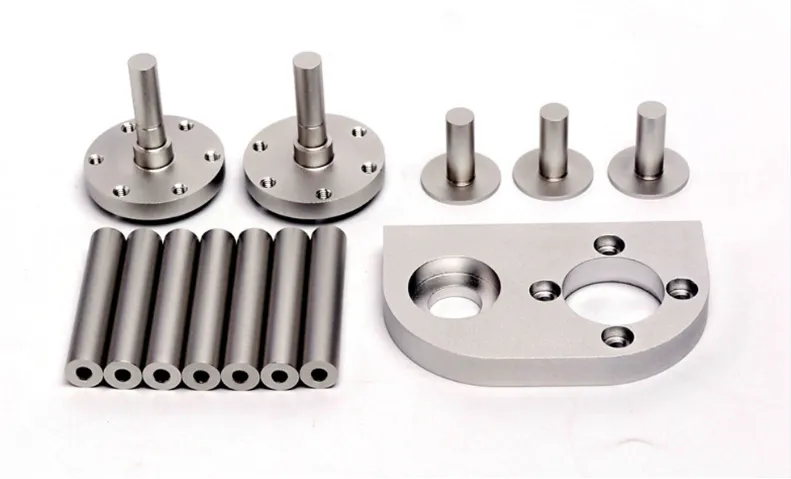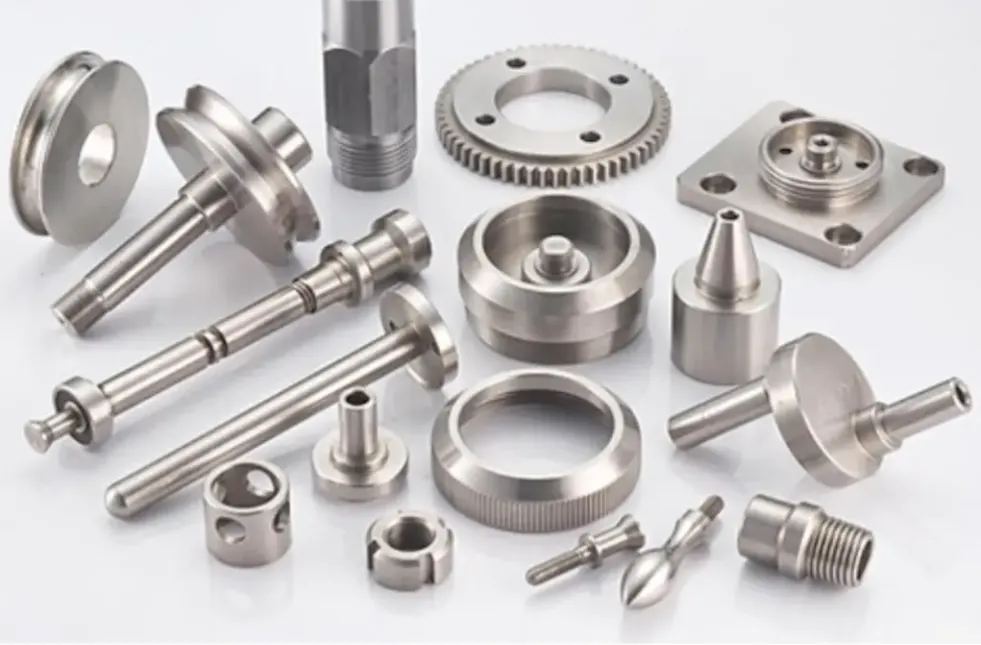CNC milling is a subtractive manufacturing process that utilizes computer-controlled rotary cutting tools to remove material from a workpiece, transforming raw stock into precision components with complex geometries. The process begins with a CAD model that is converted into machine instructions through CAM software, generating toolpaths that dictate the movement of multi-point cutting tools across three or more axes. Modern CNC milling centers achieve positioning accuracies within ±0.005 mm and surface finishes down to Ra 0.4 μm, making them indispensable for producing high-tolerance parts across industries. The versatility of CNC milling allows for the creation of diverse features including pockets, slots, holes, contours, and intricate 3D surfaces on materials ranging from soft plastics to hardened steels.
 Material selection significantly influences the milling process parameters and tooling requirements. Aluminum alloys (6061-T6, 7075) are commonly machined at spindle speeds of 10,000-20,000 RPM with carbide end mills, producing excellent surface finishes while maintaining high material removal rates. Stainless steels (304, 316) require slower speeds (500-2,000 RPM) and specialized tool geometries to manage work hardening and heat generation. Titanium alloys demand even more conservative parameters (100-400 SFM) with high-pressure coolant to prevent tool degradation. For plastic components, sharp polished tools running at high speeds prevent material melting and edge chipping. The milling process must be carefully optimized for each material type, considering factors like chip formation, thermal expansion, and cutting forces that could affect dimensional stability.
Material selection significantly influences the milling process parameters and tooling requirements. Aluminum alloys (6061-T6, 7075) are commonly machined at spindle speeds of 10,000-20,000 RPM with carbide end mills, producing excellent surface finishes while maintaining high material removal rates. Stainless steels (304, 316) require slower speeds (500-2,000 RPM) and specialized tool geometries to manage work hardening and heat generation. Titanium alloys demand even more conservative parameters (100-400 SFM) with high-pressure coolant to prevent tool degradation. For plastic components, sharp polished tools running at high speeds prevent material melting and edge chipping. The milling process must be carefully optimized for each material type, considering factors like chip formation, thermal expansion, and cutting forces that could affect dimensional stability.
The capabilities of CNC milling machines have expanded dramatically with the introduction of multi-axis systems. While 3-axis mills perform vertical machining operations on prismatic parts, 4-axis machines add rotational movement around the X-axis (A-axis) for machining complex contours on cylindrical workpieces. 5-axis milling centers provide simultaneous movement in three linear and two rotational axes (typically A and C), enabling the production of highly complex geometries like impellers, turbine blades, and aerospace structural components in a single setup. This reduces cumulative tolerancing errors that would occur from multiple repositionings and significantly decreases production time for intricate parts. Advanced 5-axis machines can achieve angular positioning accuracies within ±15 arc seconds while maintaining surface finish consistency across complex curvatures.
Tooling systems for CNC milling have evolved to meet increasing demands for precision and efficiency. Modern milling cutters incorporate advanced coatings like diamond-like carbon (DLC) or aluminum chromium nitride (AlCrN) that extend tool life when machining abrasive composites. High-performance end mills feature variable helix angles and unequal flute spacing to minimize harmonic vibration during high-speed machining. Tool holding systems have similarly advanced, with hydraulic chucks and shrink-fit holders providing superior runout accuracy (<0.003 mm TIR) compared to traditional collet chucks. Automatic tool changers with 30+ station capacities allow uninterrupted production of parts requiring multiple operations, while in-machine tool measurement systems compensate for wear and thermal drift during extended machining cycles.
Surface finish requirements dictate the selection of milling strategies and post-processing operations. Roughing operations using large diameter tools with high feed rates remove bulk material efficiently, while semi-finishing passes establish near-net shapes with controlled stock allowance. Final finishing operations employ small diameter ball nose end mills with precise stepover distances (often 5-10% of tool diameter) to achieve optical-quality surfaces. For components requiring exceptional smoothness (Ra < 0.2 μm), hard milling of heat-treated steels (45-65 HRC) with polycrystalline cubic boron nitride (PCBN) tools eliminates the need for manual polishing. Secondary processes like vibratory finishing, electropolishing, or micro-blasting may be applied to enhance surface properties for specific applications such as medical implants or fluid handling components.
Quality assurance in CNC milling involves comprehensive inspection protocols at multiple stages of production. First-article inspection verifies that the initial part meets all drawing specifications using coordinate measuring machines (CMMs) with touch-trigger probes capable of micron-level repeatability. In-process probing checks critical dimensions during machining runs to detect tool wear or machine drift before they affect part quality. For high-volume production, automated vision systems perform 100% inspection of key features using optical comparators or laser scanners. Advanced metrology techniques like computed tomography scanning provide non-destructive evaluation of internal features and wall thicknesses in complex milled components. These quality control measures ensure compliance with industry standards ranging from ISO 9001 to AS9100 for aerospace applications.
The economic considerations of CNC milling involve balancing multiple factors to optimize production efficiency. Machine utilization rates are maximized through careful nesting of multiple parts on a single workpiece when possible, particularly for smaller components. Tool life management systems track cutter usage and automatically compensate for wear, reducing unexpected tool failures that cause production delays. High-efficiency milling (HEM) strategies leverage modern toolpath algorithms that maintain constant chip loads and optimal engagement angles, allowing up to 70% faster material removal rates compared to conventional milling approaches. For prototype development or low-volume production, modular fixturing systems minimize setup times while maintaining the positional accuracy required for precision parts.
Industry applications demonstrate the breadth of CNC milling capabilities across sectors. Aerospace manufacturers rely on 5-axis milling to produce structural airframe components from high-strength aluminum alloys and titanium, where weight reduction and structural integrity are paramount. The medical device industry utilizes micro-milling to create surgical instruments with intricate features and ultra-smooth surfaces that meet stringent sterilization requirements. Automotive suppliers employ high-speed milling for producing injection molds with conformal cooling channels that improve plastic part quality and reduce cycle times. Energy sector applications include milling large turbine components from nickel-based superalloys that withstand extreme temperatures and pressures in power generation systems.
Emerging technologies continue to expand the possibilities of CNC milling. The integration of additive manufacturing with milling creates hybrid machines capable of building near-net shapes through deposition processes followed by precision milling to final dimensions. Artificial intelligence systems now analyze machining data in real-time to optimize cutting parameters dynamically, adjusting feeds and speeds based on actual tool performance rather than theoretical models. Digital twin technology allows virtual simulation of the entire milling process before cutting begins, identifying potential collisions or process inefficiencies. These advancements are driving CNC milling toward smarter, more connected manufacturing systems that maintain the precision of traditional machining while achieving new levels of productivity and flexibility.
Environmental considerations have become increasingly important in CNC milling operations. Modern machine tools incorporate energy-efficient spindle motors and axis drives that reduce power consumption by up to 40% compared to previous generations. Coolant management systems filter and recycle cutting fluids, extending their usable life while minimizing waste. Dry machining techniques and minimum quantity lubrication (MQL) systems significantly reduce fluid usage while maintaining tool life and surface finish quality. Chip management systems separate and compact different material types for efficient recycling, with aluminum chips particularly valuable for remelting into new billets. These sustainable practices align with industry initiatives to reduce the environmental impact of precision manufacturing while maintaining the high quality standards required for critical components.
The future of CNC milling parts production lies in further integration with digital manufacturing ecosystems. Cloud-based toolpath optimization software can now analyze parts from multiple customers to maximize material utilization across an entire production facility. Blockchain technology is being implemented to create immutable records of machining parameters and inspection results for quality-critical components. Advanced robotics are increasingly handling part loading/unloading and post-processing tasks, creating lights-out manufacturing cells that operate continuously with minimal human intervention. As these technologies mature, CNC milling will continue to evolve as the foundation of precision manufacturing, capable of producing increasingly complex parts with tighter tolerances and superior surface finishes across an expanding range of engineering materials.








